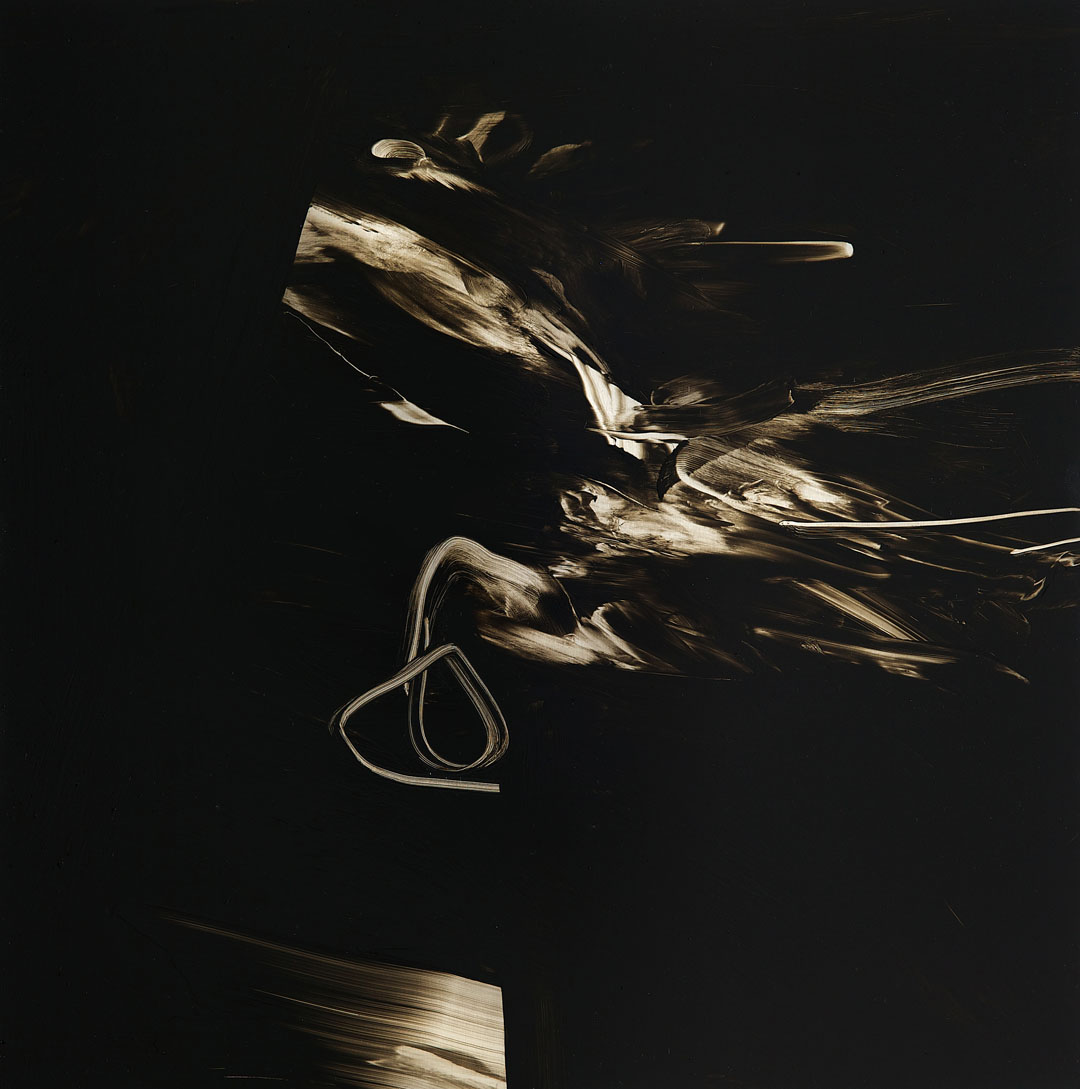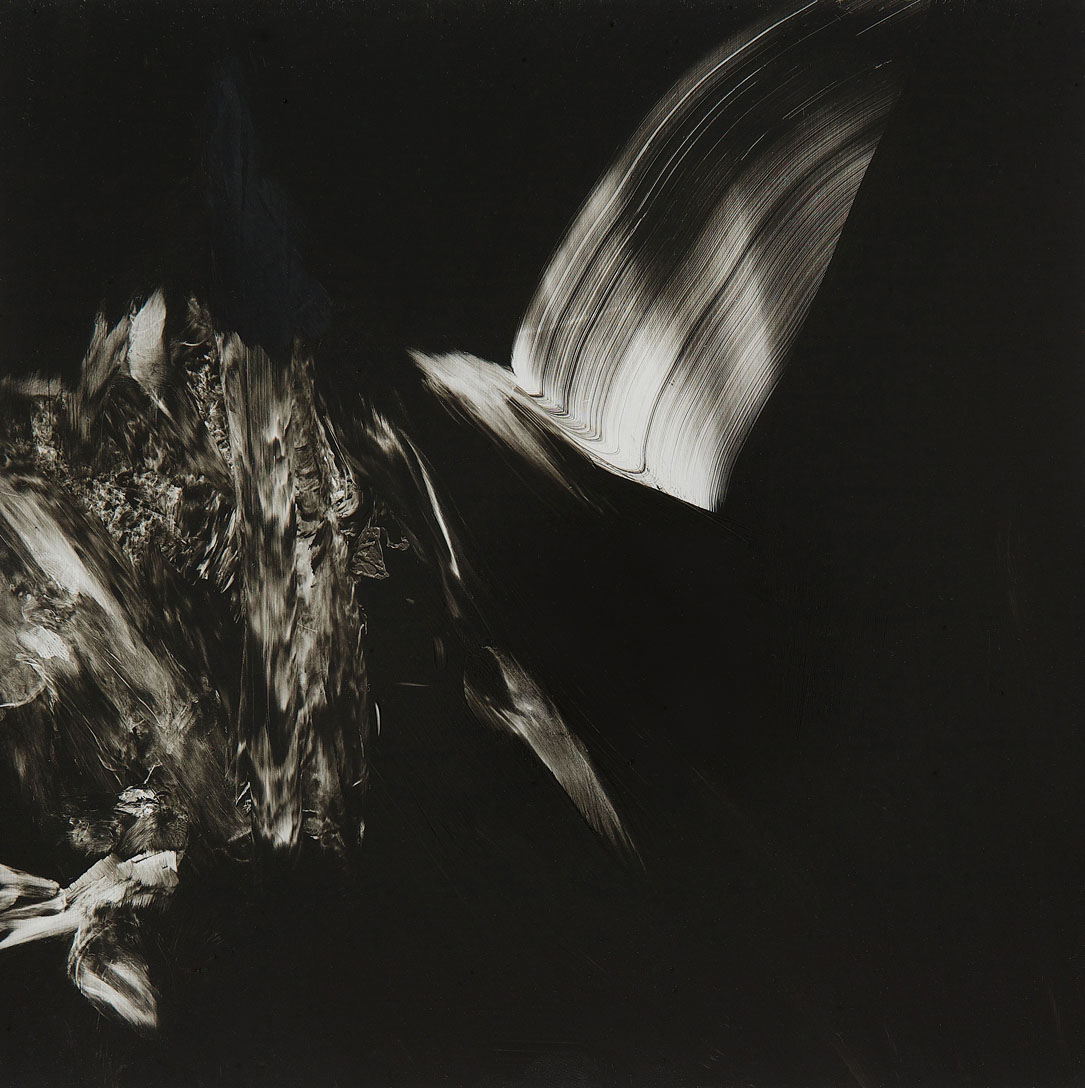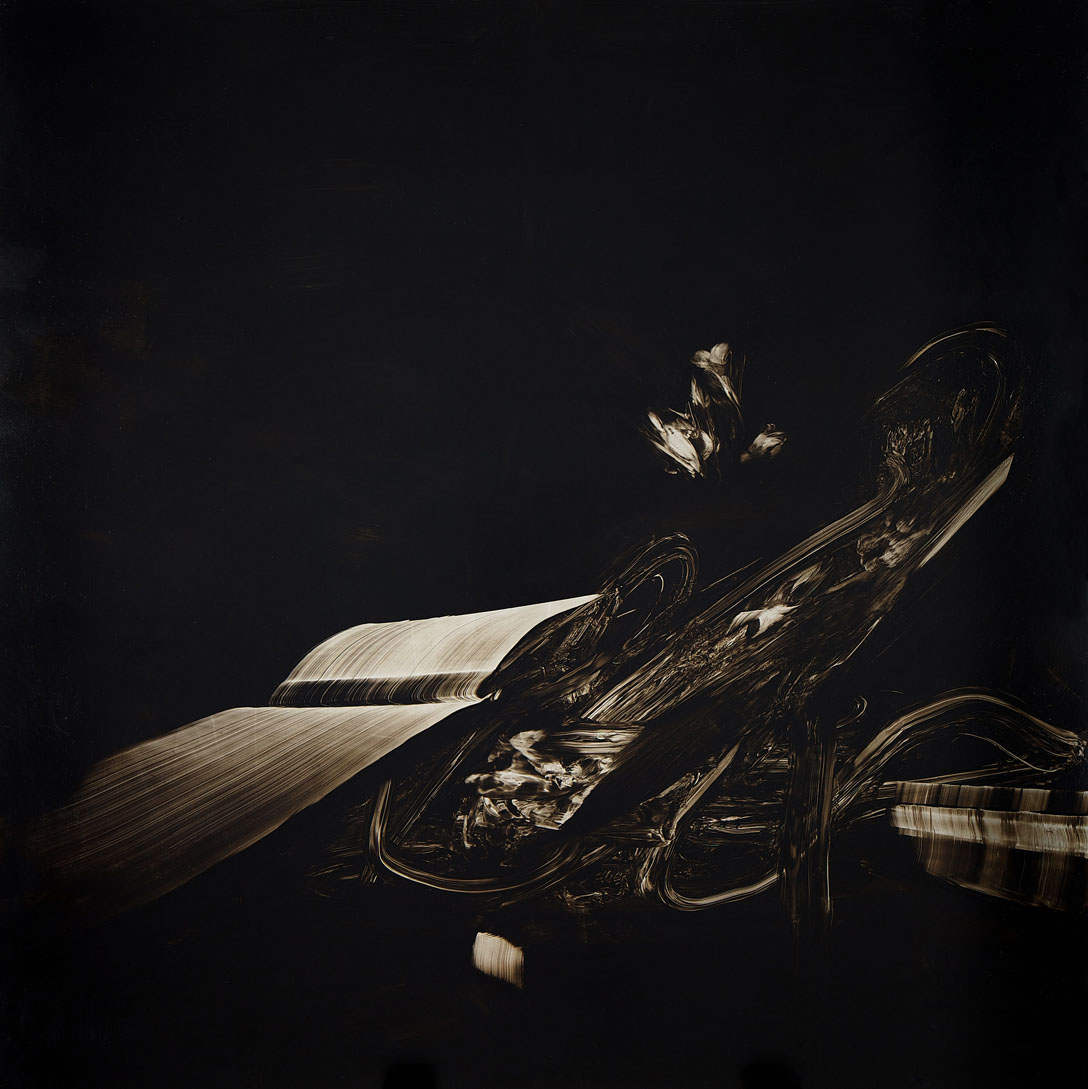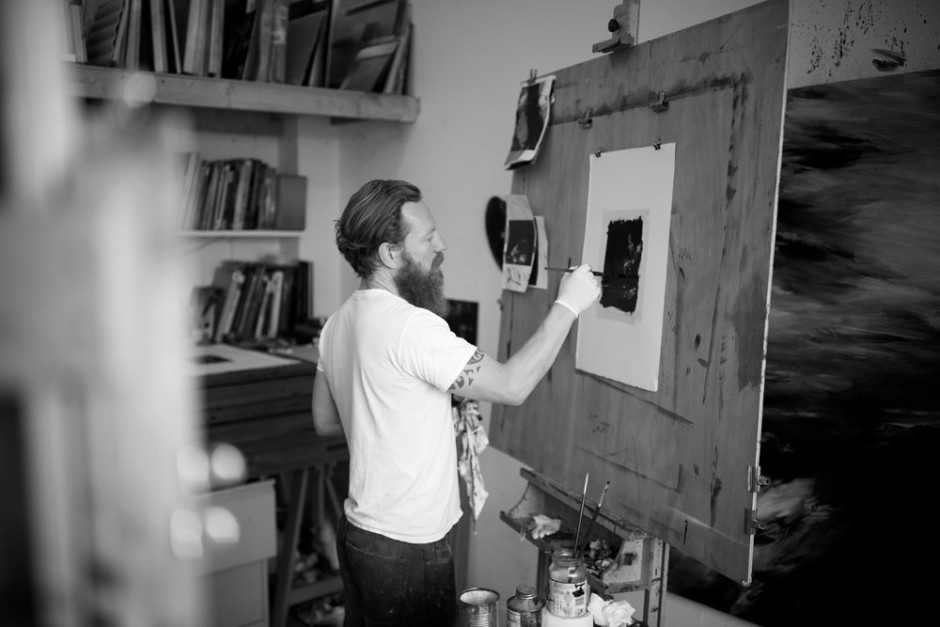Abstract painting rarely comes as close to forming a figurative image as it does in the paintings of London-based Jim Threapleton, or so elegantly. And yet it does somehow remain entirely abstract. It must be an incredibly fine line to tread standing in front of the easel, pushing abstract marks to the brink of depiction: go too far one way and it will tip the balance either into the realm of pure abstraction without the slightest suggestion of representation, or, on the other hand, to the point where it looks like the artist is trying too hard to make something resemble ‘real things’ without actually depicting them.
It is a line that Threapleton has spent the past five years of a PhD in painting at Camberwell and Chelsea exploring, so it is perhaps not surprising that he has achieved such a high level of accomplishment with both his techniques and in his thinking about painting. In fact, there is both an uncanny sense that Threapleton has mastered his medium, and simultaneously that he is only at the beginning of his journey, like someone figuring out how DNA works and in the process opening an entire new door to the future of genetic research. Threapleton opens just such a portal in terms of abstract painting.
His striking, often monochrome practice is very much a conversation – perhaps a kind of battle – between darkness and light, in some respects not unlike an old still life painting in terms of matter being presented in front of a backdrop of undefinable darkness, but with a markedly different set of parameters to the works of old masters such as Caravaggio, Chardin or Cotán. Threapleton’s is a twenty-first century dialogue between nothingness and something, between the void and matter, between death and life, impossibility and possibility. With an almost existential gravitas, his paintings are a duel between painting and immateriality, with the stakes existence or the abyss. I perhaps wasn’t fully prepared for this on arriving at Threapleton’s studio in South London one sunny afternoon in early summer…
So often abstract and figurative art lead in different directions, as if they are two opposing camps, but maybe sometimes they can be thought of as being on a spectrum, on a sliding scale with a point of convergence where mark making and representation have not yet chosen their final state of being, opting instead for an indeterminate, unstable state. Just as the process of making a representational work of art starts with abstract marks and grows into a recognisable form with dimensions, shapes and tones, Threapleton’s paintings are abstractions that are in the process of becoming figurative yet never arriving there, always in the midst of forming yet never becoming. In his practice he is circumnavigating the moment at which abstraction triggers our eyes and minds to want to try to read the imagery as if it were a depiction of real objects in real space, but there are no real objects and there is no real space. Instead, our eyes and minds are caught in a cognitive trap of sorts, in limbo between differing routes for mental image processing. It is an exciting place to be as we’re geared up to decipher, ready to interpret, poised to make up the missing pieces of visual information, but the answers are in our minds, the questions in the painting.

Untitled V, 2015. Oil on stainless steel, 40 x 40 cm. Courtesy and © of the artist.
In Untitled V (2015) a strange form seems to be flying through space, brightly illuminated against a background of complete blackness. It is as if it is pouring out of the darkness, a short straight diagonal line defining the seam or slit through which the light and matter cascades out. Painted in oil on stainless steel, the exposed steel serves as the source of light within the image, creating a complex sense of spatial dimensions and form, shadows and contours. While we have no idea of the scale of the matter we are looking at, we can see a lot of visual information pertaining to the matter itself – some sections appear like weather-worn bones or geological striations, other passages are less opaque, giving the impression more of gases or liquids, trails of particles being projected out or pulled away from the main body of matter. A long thin tube or tape, like the antenna or feeler of some sea creature or the root of a plant emerges from the centre and works its way to the edge of the painting before coming back inwards. A thicker yet more transparent tape at the bottom left of the image works its way out and round in a loop, as if being squeezed out of a tube. Shards of matter, some like metal blades or glass, others more like feathers, cut through the space in myriad directions, some with a sense of thrusting forth, others as if floating serenely. A concerto of different dynamics, energies, masses and materials, the painting feels deeply primordial, as if we are witnessing matter itself coming into existence, particles forming into clouds, elements combining, galaxies taking shape. And out of this come signs of life, organic activity, cell division, reproduction. The blackness might imply a weightlessness, an absence of gravity, but it also feels like it might be in the wind or under water, where currents are moving things around: it is a symphony of particles and waves, and whether on a micro or macro level – through the microscope or the telescope – Threapleton has created something both elemental and primeval that shines amid the dark.

Symptom XIV, 2015. Oil on aluminium, 25 x 25 cm. Courtesy and © of the artist.
This sense of the artist depicting matter forming, of evoking fundamental forces and processes, is continued in the series ‘Symptom’ (2015). In Symptom XIV, two forms can clearly be discerned emerging from the blackness. On the left, a dense, detailed form resembles undergrowth thick with moss, foliage, leaves, grasses and reeds, but also has something bestial about it, the lines and marks evoking fur, tufts of hair, whiskers and spines as on a hedgehog or badger. It is, of course, completely abstract – the complexity of marks triggering associations in our minds that will remain unanswered, forever unresolved. Above and to the right, a second, very different form can be seen. A fairly thin, flat but broad passage of paint comes sliding into the centre of the image, sweeping in like a broom leaving a trail of hundreds of undulating parallel lines of dust. They look like the grooves in a wonky old record, the threads on a loom or the rings around a planet such as Saturn. Towards the end of the swoop the lines take a small but sudden change of course before trailing off into a smear, a scuff. The form contains a feeling of motion, time and space, a sense of a gesture occurring in time. It could be a reading on a chart or monitor capturing a very slow process, or something almost instantaneous – millennia or nanoseconds. It could contain vast amounts of data, or next to none, fading out as clearly as it came into existence. This existence is, again, a conflation of waves and particles, of energy, light and matter. There is a strong sense of the ontological in Threapleton’s oeuvre – of things coming into being, of things existing, and of our role in observing and rationalising them.

Symptom X, 2015. Oil on stainless steel, 100 x 100 cm. Courtesy and © of the artist.
But while Threapleton’s compositions and techniques might lead us to grand narratives such as space, time and being, there is also something very grounded and on an inherently human scale in many of the works. In Symptom X (2015), there is a real sense that we are looking at a still life or a vanitas painting from the history of art. Just as in Dutch and Flemish painting of the seventeenth century, in which objects such as books, skulls, musical instruments, candles and animals are intended to make us reflect upon our own mortality, depicted in heavy chiaroscuro against black backdrops and dark curtains, so too does a work such as this by Threapleton. Here his abstract marks give the impression of various objects, materials, textures and surfaces being presented in the foreground of the image, a smooth flat passage on the left triggering a strong mental association to a book with its pages spread open. A delicate, detailed form floats in the air like a small posy of flowers, while the shapes below evoke the neck and scroll of a stringed instrument with ribbons and tassels flowing around it. Reading the composition as a kind of vanitas painting, abstraction here plays host to an allegory for mortality, to how the material culture we produce and consume is a reflection of the lives we have led and our inevitable march from youth towards death. And it is the process of painting itself, the gesture of mark making, that is the opposition to, or rather, the mechanism through which, death, absence and nothingness come into being. In Threapleton’s own words, his work is a form of vanitas painting ‘reconsidered through the prism of abject gesture’.
These monochrome works (and my visit to the artist’s studio revealed there are works in colour on the horizon too) with their impressive lexicon of smears, smudges, scrapes and scuffs, sometimes feel like prints or engravings, in part due to the combination of very detailed, tiny lines and marks and the subtly graded contrast between brightness and darkness that the steel or aluminium supports set off. It is no surprise to discover that Threapleton is very interested in printing processes, making monoprints and studying how ink can be made to interact with the plates and paper as a way to think about how oil paint can interact with different types of surface. His marks, a dance between masterful control and contingency, are like darkly beautiful, cryptically poetic gestures in space and time, gestures through which light is brought out of the darkness, and in the process matter is brought into being. Just as perception and cognition allow us to engage with the creation of a work of art, so too does the work of art allow us to engage with creation in its very broadest sense.
Words: Matt Price
Image top: Jim Threapleton in his London studio, 2016. Photo by Julian Cornish-Trestrail.







